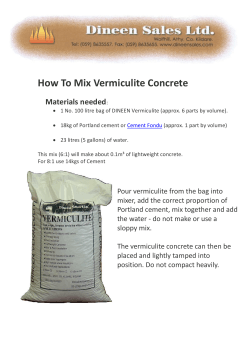
Media release NEW IMPORT TERMINAL UNDERWAY IN TIMARU
Media release Embargoed until 3.30pm, Wednesday 15 October 2014 NEW IMPORT TERMINAL UNDERWAY IN TIMARU A milestone for the Timaru economy was celebrated today with the official groundbreaking for Holcim New Zealand’s new $50million cement import terminal at the region’s port. The Member of Parliament for Rangitata, Hon Jo Goodhew planted a tree to celebrate the groundbreaking – a symbol of the care and value Holcim places on environments in which it operates. The old silos have already been demolished by PrimePort and the site is clear for construction to begin on the new import terminal. The company has all the approvals required and continues to work closely with PrimePort and the Timaru District Council. Holcim has invested many millions in mitigation measures. Holcim’s Managing Director, Jeremy Smith says this investment can be taken as a sign of the global company’s confidence in the strength of the New Zealand market and in particular the opportunities with the rebuild of Christchurch post earthquake. “The Port of Timaru terminal provides effective access to the major market of Christchurch, utilising the new $5million silo capacity completed in January 2014 at the Lyttelton Port of Christchurch. This terminal also provides effective distribution to the whole of the South Island market and the lower North Island as well.” “The terminals will be a demonstration of the best in global fit-for-purpose design and port environments.’ Up to 50 people will be employed at the Timaru site during the construction phase and up to 8 once fully operational. Construction will now get underway in ernest and the timeframe for having the terminal fully operational is planned for the first quarter of 2016. Holcim thanked the local community for its support of the company and this major project. The company also launched a local scholarship programme as a further way of thanking the community and demonstrating its investment is for the long term. Background • Holcim provides competitive access to a basic, essential building material used in nearly all commercial, industrial and residential buildings. Its cement supply strategy is of critical importance to the construction sector of New Zealand. • HNZL had previously announced that it was moving to a business strategy of importing and distributing bulk cement for supply to the New Zealand market and moving out of manufacturing. • HNZL will concentrate its business on importing and distributing cement and the downstream businesses of ready-mix concrete and aggregates. • The company has all the final approvals to go ahead with its investment of more than $100 million to build two 30 000 tonne import terminals, one in Timaru and one in Auckland [Waitemata]. • Construction has started at the Port of Timaru during August 2014 with construction in Auckland planned to commence in December 2014. About The New Cement Import Terminal at PrimePort The cement import terminal will consist of the following: • • • • • • Two berthing facilities; one for 35,000 tonne (handy-sized) vessels and one for smaller coastal distribution vessel(s); A shore based ship unloading facility; A cement storage dome with a capacity of approximately 30,000 tonnes; Ship loading system for domestic distribution by coastal ship(s); Load out facility for bulk cement trucks, with the future possibility of some distribution by rail; Ancillary building facilities (office, staff amenities and workshop). Cement Storage Holcim is building a “Dome” cement storage facility with capacity for 30,000 tonnes of cement. Storage domes are used commonly throughout the world; however Holcim’s proposal will be first for New Zealand. The dome is constructed using a waterproof; tear resistant, industrial roofing membrane which is attached to a pre formed ring foundation and then inflated. Once inflated, the construction process is completed from inside the dome avoiding delays from inclement weather. Polyurethane foam insulation is then sprayed on the inside surface of the dome to provide initial rigidity and a thermal barrier from the outside elements protecting the dry bulk storage product (cement) from condensation. Reinforcing steel is then attached to the foam providing additional rigidity and a skeleton structure for which shotcrete (sprayed concrete) is then applied. Shotcrete is applied in thin layers and combined with the installation of additional steel reinforcing at various thicknesses a process which continues until the appropriate strength is reached. Holcim has selected to use a dome storage facility over the traditional vertical concrete or steel silo due to its lower construction cost, rapid construction irrespective of the weather and improved aesthetics over a conventional concrete structure. On completion the storage dome height will be 33.5m, including the height of filter houses and pipework, and the diameter will be 36 m. Ancillary Facilities There will be a single storey building which will contain office space and associated amenities. A separate building will contain an electrical room and an air compressor room to provide air transporting the cement. Hours of Operation and Workforce The construction workforce will employ up to 50 people at its peak, with construction expected to last for a period of 17 months. During the construction period, work hours will be variable depending on construction requirements at the time; however it is expected that work will be carried out six days a week. There may be some occasions where work will need to occur up to 24 hours a day, seven days a week when activities such as concrete pouring and dome erection work are being undertaken. During operations, the cement import terminal will be available to operate 24 hours day, seven days a week and Holcim expect it to be manned by around 8 fulltime staff. Site Access and Parking Two new accesses have been designed to minimise the need for light vehicles to share internal roadways with bulk tankers and to provide a safer access onto Port Loop Road. • Truck-only entrance to allow access to truck load-out facilities. This will be on Port Loop Road, approximately 250m south of Marine Parade. Separate automatic gates will be provided into the facility which will open on the trucks approach to avoid any delay following vehicles. • An all-movement access will provide for two-way traffic into and out of the office car park for light vehicles and allow egress for trucks via an internal circulatory system within the site. This is located approximately 160m south of Marine Parade on Port Loop Road. Port Facilities PrimePort will provide Holcim with preferential use rights to two berths on No. 2 Wharf. The wharf will be strengthened and upgraded to ensure it is suitable for Holcim’s project. PrimePort is responsible for any upgrade/replacement to the wharf as well all wharf construction consenting requirements. PrimePort Timaru will provide, own, maintain and upgrade (if required) all necessary berths. Import Shipments With the distances that cement will be delivered, the size of the import ship influences freight costs. Holcim anticipate that handy-sized ships capable of carrying up to 35,000 tonnes will be the most economical. This allows for back loading freight, such as logs, thus optimising operations for Holcim, PrimePort and the respective shipping company. It is envisaged that cement from each import shipment will be delivered to the two import terminals (AucklandWaitemata and Timaru). Ship Unloading Unloading of imported cement will be undertaken pneumatically with dedicated pipelines, located on and under the wharf, which feed directly into the storage dome. This diagram shows a cross section of infrastructure required to receive cement import shipments. Cement is lifted from the ships hold by the ship unloader and then becomes fluidised with the addition of compressed air which propels it through the pipeline to the storage dome. Once the cement has reached the storage facility, the conveying air is vented through bag filters (located on the dome roof) to the atmosphere. Cement Distribution Supply to the local market (Timaru and surrounding areas) will be by bulk road tankers. The use of rail for transport around the South Island will be considered in the future. A majority of the cement re-distribution for the lower North Island and the South Island will be undertaken by a coastal bulk ship. When the terminal is operational, this will be undertaken by the Holcim owned MV Milburn Carrier II. Average coastal ship cargo capacity is estimated at around 7,000 tonnes. The number of domestic shipments from Timaru is initially expected to be 1-2 shipments per week. The ship will be loaded by an enclosed conveying pipeline. Cement is transferred from the storage dome via a pumping unit, compressed air is added and the fluidised cement is pumped along the pipeline into the ship as indicated below. CONVEYI NG UNI T DI RECT I ON OF CEMENT F L OW S HI P - PI PEL I NE P I PEL I NE F ROM NOT T O S CAL E DOME CONNECT I ON POI NT S About Holcim’s Community Support Programme Community Initiatives With around 30 sites throughout New Zealand, Holcim New Zealand aims to make a positive contribution to each of the communities it operates in and actively works to ensure it is a responsible and good neighbour. Sustainable operations at Holcim sites and community involvement and support are ways they can ensure this happens. In each community, Holcim New Zealand partners with local stakeholders to improve educational, social and cultural development. Scholarships Holcim New Zealand has built on the success of educational scholarships it has offered in the Buller area for more than 28 years. Since 2009 Holcim has extended scholarship opportunities to several other communities in which we operate: Hastings, Franklin and Wellington districts. As part of this commitment to communities, a scholarship opportunity is being offered in Timaru for 2015, now that Holcim is establishing an operational site in the area. In general, the scholarships offer $2,000 per annum (maximum of 3 years) towards tertiary study costs plus, where available, paid work at the relevant Holcim site during the holidays for the duration of the scholarship. Since the Timaru site is not yet operational this scholarship will initially offer $2,000 each year for three years, excluding holiday work. Preference is given to students who have a connection with the community and whose studies are relevant to Holcim’s industry. As at other sites, community representatives from Timaru will be included in the application and selection process for the Timaru scholarship. Employee Volunteering Holcim New Zealand employee’s are encouraged to volunteer in their community for one day a year as part of Holcim’s Employee Volunteer Programme. Staff have enjoyed a real variety of volunteer work including; cleaning local creeks, delivering and helping plant trees and shrubs at schools and pre-schools, planting and tidying up walking/cycling tracks, planting and erecting protective fencing for penguin habitats, removal of graffiti and clean up of local shopping centres, gardening at local maraes, helping those in need after the earthquakes in Christchurch, and helping out at a zoo in Hamilton that relies on volunteer labour to operate. Media site tour Journalists are invited to visit the Timaru site prior to the official ground breaking. This will provide an opportunity to be briefed on the design and operation of the new terminal. Access to the site is limited but Holcim people will be able to point out and show media where the terminal will be and how it will be operated. You will need to wear flat and covered-in shoes. This briefing will start at 2.30pm prior to the 3.30pm official ground breaking. If you wish to attend please contact Ken Cowie [ken.cowie@holcim.com]. For further information: Joanne Graham Executive Assistant Corporate Christchurch Phone +64 3 339 7593 Mobile +64 21 083 77272 Fax +64 3 339 7499 Joanne.Graham@holcim.com www.holcim.com
© Copyright 2025










